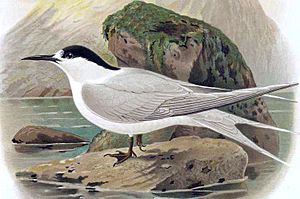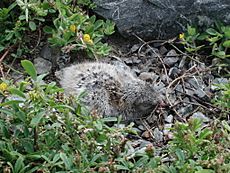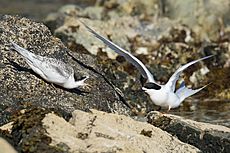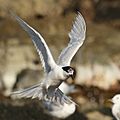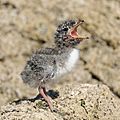White-fronted tern facts for kids
Quick facts for kids White-fronted tern |
|
|---|---|
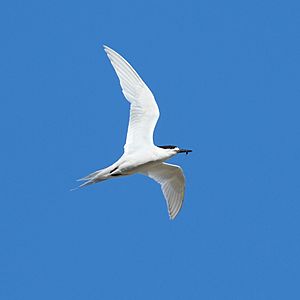 |
|
| Sterna striata in flight with tiny fish in its beak | |
| Conservation status | |
| Scientific classification | |
 |
|
| Range of S. striata Resident Non-breeding |
The white-fronted tern (Sterna striata) is also known by many other names like Tara, Sea Swallow, or Kahawai Bird. It was first described by Johann Friedrich Gmelin in 1789. This bird is a medium-sized tern with a white body and a forked tail. Its upper wings are grey. When they are ready to breed, adult terns have a black cap on their heads. This cap goes from their forehead to the back of their neck. A small white stripe stays across the top of their black beak.
White-fronted terns are the most common terns in New Zealand. You can see them eating fish along the whole coastline and on many smaller islands. They build their nests from October to January. They choose rocky cliffs, offshore islands, or coastal areas with shingle, sand, shells, or rocks. Hundreds of breeding pairs can nest very close to each other in large groups. Many young terns and some adults fly to the southeast coast of Australia and parts of Tasmania in autumn. Some even start new breeding groups on Flinders and Cape Barren Islands.
Sadly, animals like ferrets and stoats have been brought to New Zealand. These animals hunt the terns. Because of this, the white-fronted tern is now considered "at risk" in New Zealand. This means their numbers are going down.
Contents
About the White-Fronted Tern
White-fronted terns are medium-sized birds. They are usually about 35 to 43 centimeters (14 to 17 inches) long. Their wings can spread out to 79 to 82 centimeters (31 to 32 inches) wide. On average, they weigh about 130 grams (4.6 ounces). Female terns are a little smaller than males. However, it's hard to tell them apart when you see them in the wild.
These terns have simple colors. Their body, tail, and the underside of their wings are all white. Their upper wings are a light, shiny grey. During the breeding season, some birds might have a faint pink color on their chest. But you can't always see it.
Their darkest parts are their beak, black cap, eyes, and feet. The tips of their wings also have dark shadows. Their long, thin beak is black and pointy. It gets a bit duller in color at the very tip. The black cap on their head covers from their forehead to the back of their neck. It never touches their beak, leaving a white band across their lower forehead. Their round, black eyes are inside this cap. Their legs are short and a dark reddish-black color.
A special feature of the white-fronted tern is its forked tail. This tail looks like a swallow's tail and is easy to spot when they fly. During the breeding season, the outer feathers of their tail grow longer. This makes the fork even more noticeable.
When adults are not breeding, their black cap shrinks. It moves back towards the top of their forehead and above their eyes. It also looks less dark. Young white-fronted terns look similar but have white speckles in their cap. They also have slight brownish-cream colors on their wings and tail.
Very young terns, called juveniles, look quite different. They have light to dark grey and warm brown colors on their upper wings, back, and shoulders. Their cap is not fully formed and looks patchy. They also have dark black marks in front of and behind their eyes.
Where They Live
Global Homes
White-fronted terns live in New Zealand and Australia. Young terns sometimes fly across the Tasman Sea to southeast Australia and northern Tasmania. In Australia, they only breed on Flinders and Cape Barren Islands in the Bass Strait.
New Zealand Homes
These terns are the most common type of tern in New Zealand. They live all along the coastline. In the North Island, many live from Auckland to the Bay of Plenty, including the Coromandel Peninsula. They are also common along the coast from Wellington up to Manawatu. In the South Island, you can often see them in the Marlborough Sounds and along the eastern coast. This includes Canterbury, Otago, and Southland, where they stay all year. Stewart Island also has groups of terns and breeding pairs throughout the year.
Besides the main coastlines, they also live on many smaller islands. Large numbers of breeding pairs have been seen on Chatham and Auckland Islands. They usually stay near the coast. But sometimes, they go inland a few kilometers. For example, in Canterbury, they fly up large braided rivers to find food and build nests.
Life Cycle
How They Find Mates
White-fronted terns start looking for partners in early October. This is when spring arrives and the weather gets warmer. This can continue until January, as more birds arrive at the breeding spots.
A male tern will fly in from the sea, holding a fish carefully in his beak. He flies above groups of females and calls to get their attention. He might land and walk around with his head and fish held high. This is to get more attention from possible mates. A female might come closer, hoping he will feed her the fish. But at this point, the male will quickly fly off. One or more females will follow him closely. This show continues until only one female is left following him.
The pair will then land together. The male might offer the fish to the female. This means he accepts her as his partner. Or, he might not like the female and eat the fish himself. If she is accepted, their partnership begins. They fly together, following each other in a beautiful display of flight. This shows they are now a couple. White-fronted terns stay with the same partner for the whole breeding season.
Nests and Eggs
Soon after finding a partner, the tern pair chooses a spot for their nest. They don't put much effort into building nests. It can be directly on the ground or a rocky area. Sometimes, the spot already has a nest-like shape. Other times, they might bring small stones to line the bottom of the hollows.
Nests are packed very close together, sometimes less than a meter apart. In large groups, there can be hundreds of nests. Many birds in a group lay their eggs on the same day. Some differences happen because of the age of the adults. Older birds lay their eggs earlier in the season.
They usually lay 1 or 2 eggs. Very rarely, they might lay 3. The eggs are speckled brown and have a pale base color. This color can be green, blue, or brown. The eggs are about 46 by 33 millimeters (1.8 by 1.3 inches) on average. Both the male and female take care of the eggs. They sit on them for about 24 days until they hatch. Adults continue to join the group and lay eggs from October to January.
Growing Up
The colors of tern chicks can vary a lot. They might be a mix of greys, browns, whites, and blacks. They look speckled and fluffy. Chicks stay in the nest for several days. Both parents keep them warm. After about a week, the chicks leave the nest. They join other chicks in a "crèche," which is like a nursery. Here, they are safer because there are more of them. This allows the adult terns to go find food. If a chick is lost to a predator or a natural event, the parents might lay more eggs. Adult terns usually only raise one chick until it can fly, even if they laid two eggs.
Parents care for their chick for 29 to 35 days. After this time, the chick becomes a "fledgling," meaning it can fly. During this time, the chick grows a lot. Its wings and body become similar in size to the adults. Young terns learn to fly and start to explore with the adults away from the colony. The adults continue to feed them for up to 3 months.
Young Terns
After they can fly, young terns shed some of their feathers and grow new ones. This happens from March to April and continues until June or July. Most young terns stay with their group along the New Zealand coast. They do not fly away to other places.
However, in autumn, many young terns and some adults fly across the Tasman Sea. They arrive on the southeast coast of Australia. They are commonly seen there from May to November before they return to New Zealand. Over the next two years, they will shed feathers and grow new ones, just like the breeding adults. This happens before breeding (May–August), after breeding (January–August), and again before the second breeding season (May–August). They slowly get their adult feathers with each change. By the second pre-breeding change, they look like adults. After two years, they are old enough to breed. But it's rare for them to breed so young. Most adults start breeding when they are about 7 years old.
Adult Life
Adult white-fronted terns can live for more than 18 years. One tern was even recorded living for 26 years! Adults shed their feathers twice a year. The first time is after breeding, which takes about 6 months from January to early August. The second time is before breeding, starting around May or June and finishing in July or August. During the pre-breeding feather change, the adult's black cap grows further down its forehead. This leaves only a small white band across the top of its beak.
What They Eat and Who Eats Them
Diet and Foraging
White-fronted terns are meat-eaters. They mainly catch fish in coastal waters. But sometimes, they will fly a few kilometers inland. They follow rivers and creeks to find food. Their diet is mostly smaller fish like smelt and pilchards. They also eat very young fish.
When they are at sea, they prefer to eat fish that swim in large groups, called shoals. These fish are often forced to the surface by bigger fish like kahawai and kingfish. When hunting, the terns dive from 3 to 10 meters (10 to 33 feet) above the water. They just barely enter the water in a shallow dive. They can feed like this in huge groups off the coast. These groups can have hundreds or even thousands of birds. They often feed alongside other birds like gannets, shearwaters, and gulls. They are very good at diving for fish. Their forked tails and excellent flying skills help them move well above the water.
Predators
Since 2016, the white-fronted tern's conservation status is "at risk/in decline." Even though there are many of them, their numbers are expected to drop in the coming years. Their population is falling because of several animals that have been brought to New Zealand. These animals hunt the terns.
Adult terns are attacked and killed by cats, weasels, ferrets, and stoats. These same predators also hunt the terns' eggs and chicks. Rats and hedgehogs also put pressure on white-fronted terns by only eating their eggs and chicks. Terns live and breed in large, tightly packed groups. But this often doesn't protect them from these new attackers.
Red-billed gulls and black-backed gulls are the only native birds that hunt white-fronted terns. However, they only eat eggs and chicks. These gulls often nest near white-fronted terns, which might be why they hunt them. Skuas are also known to attack terns in the air. When terns fly back from the sea with fish, skuas will bother them until they drop the fish. The skuas then catch the fish before it falls into the sea.
Conservation Status
A recent report from the Department of Conservation says that the white-fronted tern (S. striata) is "At risk, declining" in New Zealand. It is also considered "Regionally Endangered" in the Wellington Region. This means their numbers are going down and they need help.
Other Information
Voice
White-fronted terns make a dull "crek" sound during courtship. The male uses it when flying above groups, and other birds might answer with the same sound. When they fly down to scare away intruders, they make a continuous "keark" sound. They often use a high-pitched "siet" sound to talk to each other while flying. They repeat this sound over and over at regular times.
Monitoring and Study
It can be hard to watch and study white-fronted terns. This is because they are unpredictable. It's especially clear during the breeding season. White-fronted terns rarely return to the same breeding spots year after year. This makes it difficult to get a clear idea of their numbers and how well they are breeding.
Close Relatives
The white-fronted tern is closely related to several other tern species. These include the Common tern (Sterna hirundo), Roseate tern (Sterna dougallii), Black-naped tern (Sterna sumatrana), South American tern (Sterna hirundinacea), Antarctic tern (Sterna vittata), and Arctic tern (Sterna paradisaea).
Images for kids
See also
 In Spanish: Charrán maorí para niños
In Spanish: Charrán maorí para niños



